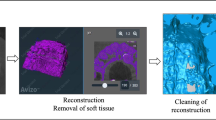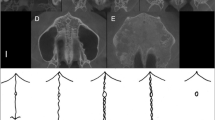Abstract
Purpose
We performed a retrospective qualitative and quantitative evaluation of the sutural changes during the physiological growth to define the age-related ossification stages of major and minor skull sutures or synchondroses.
Methods
A total of 390 healthy subjects, examined for cranio-facial trauma and whose CT scans turned out to be normal, were clustered into homogenous age-matched groups ranged from birth to 90 years. High-resolution CT was used to assess the degree of sutural closure according to a 3-grade scoring system, the sutural pattern, the width, and the density of the gap calculated as the average of two or three ROIs along each suture/synchondrosis.
Results
The identification of a definite pattern depended on the suture’s type, the closure degree, and the width of the gap (p < 0.001). The interdigitation process was more intricate for most of vault sutures than the skull base sutures/synchondroses. Closing grades 1, 2, and 3 were associated to an identifiable sutural pattern and the cutoff value of 1.45 mm of the gap width allowed to detect an identifiable sutural pattern with the best combination of sensitivity (97%) and specificity (98%). Age and sutural closing degree were inversely related to gap width while positively related to the gap density (p < 0.001).
Conclusion
The sutural ossification is an age-related process, distinctive for each suture, and synchondrosis; it occurs neither according to a predefined order along sutural arches nor following a sequential distribution in the cranial fossae, and some sutures continued their growth process during lifetime.





Similar content being viewed by others
Data availability
The data that support the findings of this study are available upon reasonable request.
References
Miura T, Perlyn CA, Kinboshi M et al (2009) Mechanism of skull suture maintenance and interdigitation. J Anat 215:642–655. https://doi.org/10.1111/j.1469-7580.2009.01148.x
Wagemans PA, van de Velde JP, Kuijpers-Jagtman AM (1988) Sutures and forces: a review. Am J Orthod Dentofac Orthop 94:129–141. https://doi.org/10.1016/0889-5406(88)90361-7
Wu Y-D, Chien C-H, Chao YJ et al (2007) Fourier analysis of human sagittal sutures. Cleft Palate-Craniofacial J Off Publ Am Cleft Palate-Craniofacial Assoc 44:482–493. https://doi.org/10.1597/06-122.1
Ruengdit S, Troy Case D, Mahakkanukrauh P (2020) Cranial suture closure as an age indicator: A review. Forensic Sci Int 307:110111. https://doi.org/10.1016/j.forsciint.2019.110111
Skrzat J, Brzegowy P, Walocha J (2002) Computed tomographic assisted study of morphological changes in the sutural areas as resulting from obliteration. Folia Morphol 61:257–259
Jayaprakash PT, Srinivasan GJ (2013) Skull sutures: changing morphology during preadolescent growth and its implications in forensic identification. Forensic Sci Int 229:166.e1–13. https://doi.org/10.1016/j.forsciint.2013.03.038
Rice DP (2008) Developmental anatomy of craniofacial sutures. Front Oral Biol 12:1–21. https://doi.org/10.1159/000115028
Sim SY, Yoon SH, Kim SY (2012) Quantitative analysis of developmental process of cranial suture in korean infants. J Korean Neurosurg Soc 51:31–36. https://doi.org/10.3340/jkns.2012.51.1.31
Bailleul AM, Scannella JB, Horner JR, Evans DC (2016) Fusion patterns in the skulls of modern archosaurs reveal that sutures are ambiguous maturity indicators for the Dinosauria. PLoS One 11:e0147687. https://doi.org/10.1371/journal.pone.0147687
Harth S, Obert M, Ramsthaler F et al (2009) Estimating age by assessing the ossification degree of cranial sutures with the aid of flat-panel-CT. Leg Med Tokyo Jpn 11(Suppl 1):S186-189. https://doi.org/10.1016/j.legalmed.2009.01.091
Willershausen I, Erbe C, Al-Maawi S et al (2019) Development of a novel histological and histomorphometric evaluation protocol for a standardized description of the mid-palatal suture - an ex vivo study. J Anat 235:180–188. https://doi.org/10.1111/joa.12985
Idriz S, Patel JH, AmeliRenani S et al (2015) CT of normal developmental and variant anatomy of the pediatric skull. Radiogr Rev Publ Radiol Soc N Am Inc 35:1585–1601. https://doi.org/10.1148/rg.2015140177
Calandrelli R, Pilato F, Massimi L et al (2018) Quantitative evaluation of facial hypoplasia and airway obstruction in infants with syndromic craniosynostosis: relationship with skull base and splanchnocranium sutural pattern. Neuroradiology 60:517–528. https://doi.org/10.1007/s00234-018-2005-5
Calandrelli R, D’Apolito G, Massimi L et al (2016) Quantitative analysis of craniofacial dysmorphology in infants with anterior synostotic plagiocephaly. Childs Nerv Syst ChNS Off J Int Soc Pediatr Neurosurg 32:2339–2349. https://doi.org/10.1007/s00381-016-3218-8
Madeline LA, Elster AD (1995) Suture closure in the human chondrocranium: CT assessment. Radiology 196:747–756. https://doi.org/10.1148/radiology.196.3.7644639
Manzanares MC, Goret-Nicaise M, Dhem A (1988) Metopic sutural closure in the human skull. J Anat 161:203–215
Paetz P, Goetz GF, Lanfermann H, Giesemann AM (2017) The developing temporal bone: computed tomography measurements and assessment of suture closure from birth to 18 years of age. Surg Radiol Anat SRA 39:663–671. https://doi.org/10.1007/s00276-016-1786-7
Bertoglio B, Corradin S, Cappella A et al (2020) Pitfalls of computed tomography 3D reconstruction models in cranial nonmetric analysis. J Forensic Sci 65:2098–2107. https://doi.org/10.1111/1556-4029.14535
Massimi L, Bianchi F, Frassanito P et al (2019) Imaging in craniosynostosis: when and what? Childs Nerv Syst ChNS Off J Int Soc Pediatr Neurosurg 35:2055–2069. https://doi.org/10.1007/s00381-019-04278-x
Coll G, Sakka L, Botella C et al (2018) Pattern of closure of skull base synchondroses in Crouzon syndrome. World Neurosurg 109:e460–e467. https://doi.org/10.1016/j.wneu.2017.09.208
Mitchell LA, Kitley CA, Armitage TL et al (2011) Normal sagittal and coronal suture widths by using CT imaging. AJNR Am J Neuroradiol 32:1801–1805. https://doi.org/10.3174/ajnr.A2673
Furuya Y, Edwards MS, Alpers CE et al (1984) Computerized tomography of cranial sutures. Part 1: comparison of suture anatomy in children and adults. J Neurosurg 61:53–58. https://doi.org/10.3171/jns.1984.61.1.0053
Coll G, Lemaire J-J, Di Rocco F et al (2016) Human foramen magnum area and posterior cranial fossa volume growth in relation to cranial base synchondrosis closure in the course of child development. Neurosurgery 79:722–735. https://doi.org/10.1227/NEU.0000000000001309
Anderson IA, Goomany A, Bonthron DT et al (2014) Does patient ethnicity affect site of craniosynostosis? J Neurosurg Pediatr 14:682–687. https://doi.org/10.3171/2014.9.PEDS14123
Funding
No funding was received for this study.
Author information
Authors and Affiliations
Contributions
Rosalinda Calandrelli: project development, data collection, manuscript writing.
Fabio Pilato: data collection, statistical analysis, manuscript writing.
Gabriella D’Apolito: data collection.
Laura Tuzza: data collection.
Cesare Colosimo: project development, manuscript writing.
All authors read and approved the final manuscript.
Corresponding author
Ethics declarations
Conflict of interest
Rosalinda Calandrelli declares that she has no conflict of interest.
Fabio Pilato declares that he has no conflict of interest.
Gabriella D’Apolito declares that she has no conflict of interest.
Laura Tuzza declares that he she no conflict of interest.
Cesare Colosimo declares that he is scientific consultant for Bracco Diagnostics Inc. and Bayer HealthCare.
Ethical approval
We declare that all procedures performed in studies involving human participants were in accordance with the ethical standards of the institutional and/or national research committee and with the 1964 Helsinki declaration and its later amendments or comparable ethical standards. For this type of study, formal consent is not required.
Additional information
Publisher's note
Springer Nature remains neutral with regard to jurisdictional claims in published maps and institutional affiliations.
Rights and permissions
Springer Nature or its licensor (e.g. a society or other partner) holds exclusive rights to this article under a publishing agreement with the author(s) or other rightsholder(s); author self-archiving of the accepted manuscript version of this article is solely governed by the terms of such publishing agreement and applicable law.
About this article
Cite this article
Calandrelli, R., Pilato, F., D’Apolito, G. et al. Time course of sutural width during the physiological growth from birth to adulthood: CT quantitative and qualitative evaluations of sutural arches. Neuroradiology 65, 701–717 (2023). https://doi.org/10.1007/s00234-023-03129-6
Received:
Accepted:
Published:
Issue Date:
DOI: https://doi.org/10.1007/s00234-023-03129-6




